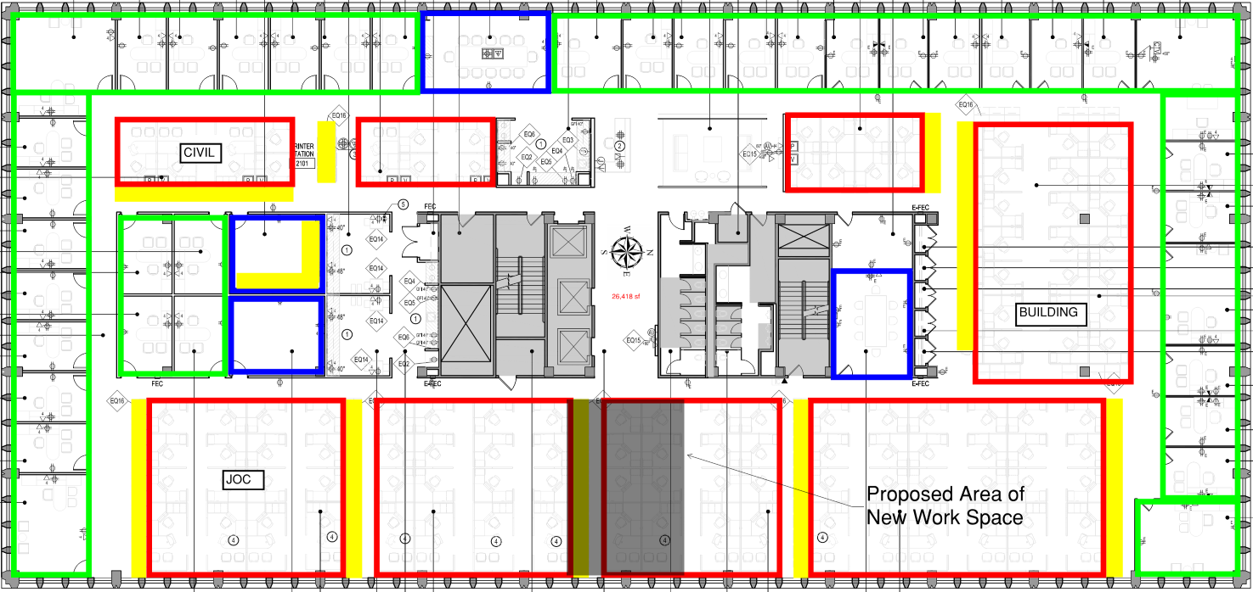F.H. Paschen Main Headquarters Collaborative Workspace
From concept to reality, our new collaborative workspace was the result of executive leadership empowering employees to invest in the future of F.H. Paschen.
“It didn’t take very long, from the minute we talked to Anthony Izzi (Vice President) and Joe Schmitz (Senior Project Manager), for them to say ‘Yes, let’s run with it!’” said Sean Lewis, Project Manager. “We started off with a survey of the existing second floor,” he explained. “We counted the offices and cubicles, and figured out how many work spaces we had, and what was occupied and what wasn’t.”
“We found we were inefficient with our space,” added Matt Cosenza, Assistant Project Manager. “We had a lot of empty, unused cubes, and we could stand to lose a few of them to build the new space. It was easier to convince people when they realized how much space we had.”
From there, they came up with general ideas of how to use the space better, which led to concepts of what it would look like. They enlisted Kyle Schram, Assistant Project Manager, who has a background in architecture, to come up with a design.
“We tried to achieve a lot of things within the footprint. We wanted to accommodate various team sizes and activities, incorporate branding, and provide flexibility for both work and social events.”
– Kyle Schram, Assistant Project Manager
Inspiration came from numerous sources. “We weren’t inspired so much by specific spaces, but by entire offices of certain companies,” said Lewis. “Their offices are laid out more like the present collaborative space, rather than rows and rows of cubes.”
Once a plan was in place, the team was encouraged by management to present their ideas to Jim Blair, President and CEO; Chuck Freiheit, COO; and Jim Habschmidt, CFO.

“We put together a PowerPoint with all of our data and our plans, and we presented them to Jim Blair and the C-Suite. It was unexpected but a cool experience,” said Matt Cosenza. “I remember it like yesterday – the room went silent. There was a 10 second pause while everyone turned their head and looked at Jim Blair, and he finally broke the silence by saying, ‘I love the idea, I think it’s great, let’s do it!'”
Once approved, it was time to incorporate other departments for input. “The design really was a collaboration, with involvement from the other department executives,” said Kyle Schram. Frank Mullaghy from Building, Mark Barkowski from Civil, Anthony Izzi from PPG, and Bill Taylor from Building were all part of the process. They all had input on concept buy-in, furniture, and finish selections, while PPG handled the details of construction.
“We did our best to mix everything together, and I think everyone is happy with the space we ended up creating,”
– Sean Lewis, Project Manager
The new space is anchored by a central feature wall with a glowing “FHP” Logo overlaid on a mural of historical project images built by the Paschen Companies over the years. Centered on the elevator corridor, soft seating is immediately available to welcome guests or collaborate over coffee.
There is a custom designed, touch screen plan table to review drawings, with an expansive white board to facilitate project planning. Adjacent to the soft seating are low tables, with a hospitality counter and television.
Behind the feature wall is a central, 12’ butcher block conference tabletop equipped with the latest technology to conduct presentations on a 70” monitor, suited for groups of up to 8, with the ability to use the taller seating to host larger audiences.
Two partial height glass walls define the space for high-top breakout tables with monitors to serve teams of four to five.
Along the exterior windows is a continuous bar-height counter top to serve individuals from remote job sites or those looking for a change in scenery.
The new space officially opened on May 1, 2018 with a ribbon cutting ceremony and tour. Since opening, it has been used by people in all areas of the company. “It’s not just for PPG or the operations divisions– it’s for field people to come in and work (if they don’t have an office), and for administrative staff as well, we love that people are using the space,” said Sean Lewis.
Kyle Schram summed up the experience of working on the project from idea to fruition. “It’s been a great experience. Instead of having an idea and being unable to act on it, we were empowered to move it forward and make it happen!”





